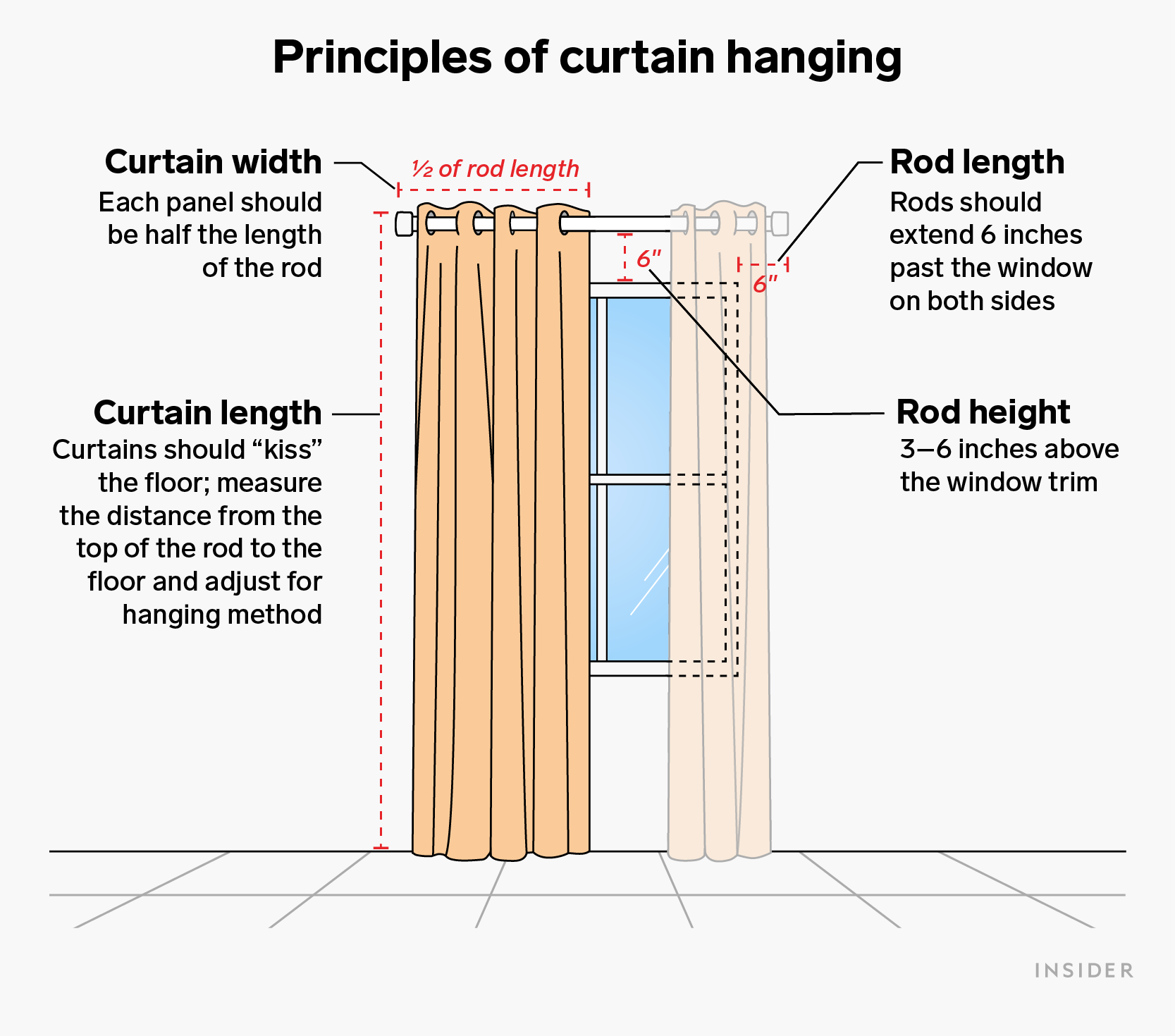
- Choosing the right curtains depends on the window and room's dimensions and the curtains' purpose.
- Ideally, curtains should be hung three to six inches above the window trim and just reach the floor.
- To hang curtains, simply screw in the brackets and mount the rod with the curtains already on it.
- Visit Insider's Home & Kitchen Reference library for more stories.
When it comes to window treatments, well-chosen and well-hung curtains are multifunctional: They control light and heat from sunlight, provide privacy, and contribute to a room's overall look.
"The first thing we always want to address when selecting a window treatment is thinking about the function," says Virginia Toledo, co-owner and creative director of Toledo Geller Interiors. "Do we need privacy in this room? Do I need it for sun protection?" Answering these questions determines how heavy your curtains should be and whether you should consider features like privacy lining or colorfastness fabrics.
Design and hanging are equally important considerations. Fabric pattern and color matter — sometimes curtains are the "hero" of the room, Toledo says, and other times "they're merely another character in the play" — and proper hanging also contributes to the look.
Hanging at the wrong height can make a room appear shorter than it actually is, while incorrect anchoring can lead to curtain rods bending over time. But when hung correctly, curtains can make rooms look taller and stay secure for years.
How to choose the right size curtains for your windows

1. Rod length
Rods should generally extend about 6 inches past the window on both sides. The rod should always be wider than the window, since you don't want curtains, when fully open, to cover the window. "You want to maintain as much of the natural light as possible," Toledo says, with the drapes just covering the window's trim on the left and right.
2. Curtain width
The width of your drapes depends on their purpose. Note that a single drape is called a panel.
- For functional or traversing curtains, each panel should be half of the total rod width.
- For decorative or stationary curtains, each panel should be 1 ½ to 2 widths of fabric wide. A standard width of fabric is 54 inches.
When it comes to stationary curtains, for a modern style like Toledo's design studio prefers, go with 1 ½ widths. For a more traditional look, go with 2 widths. "If twice fullness is used on a narrow window," says Toledo, "your drapes would look 'heavy' on either side of the window, which is a more traditional look."
3. Rod height
For rod placement, "If you have the standard 8-foot or 9-foot ceiling, 3 to 6 inches above your window trim is appropriate," says Toledo. This rule-of-thumb might be tricky with shorter ceilings or rooms with crown molding. "Go as close to the ceiling or a crown molding as possible," Toledo advises. "When you mount the rods closer to the ceiling, you give the illusion of a taller space. [It's like] a short person wearing high-waisted jeans with a long flare, right? You create this illusion of a longer leg, but the leg is still the same length."
Similarly, for taller ceilings, you may place the rod more than 6 inches above the window trim to elongate the room.
4. Curtain length
Ideally, Toledo says, curtains should "kiss the floor — just slightly touch the floor." Too-long curtains puddle on the floor, becoming a tripping hazard and cleaning nuisance, and, like too-short curtains, make a room seem shorter than it is.
To determine curtain length, measure the distance from the top of the rod to the floor. Then adjust this measurement depending on the curtain's hanging method. For example, rod-pocket curtains, which have a sewn-in pocket that the rod runs through, might need extra inches added on. Curtains hung from drapery rings need inches taken away to account for the length added by the rings.
5. Rod brackets
When selecting rod brackets, the hardware pieces that screw into the wall and support the curtain rod, keep in mind how far your window protrudes from the wall — the brackets will need to project far enough for curtains to not hit the window trim without leaving an awkward gap.
For particularly wide curtains, Toledo recommends getting a center support bracket in addition to the end brackets: "When people don't do that and don't think they need it, over time, you'll see that the rod starts to bow."
Insider's takeaway
When hung correctly, the right curtains not only play a role in controlling privacy, light, and heat, but also aesthetically contribute to a room's overall look. Choosing the right type and size curtains depends on how you want them to function and on the dimensions of the room and window.
Ideally, curtains are long enough to just touch the floor when hung from a rod installed 3 to 6 inches above the window trim. Maximizing the height of curtains helps a room look taller. Remember to choose a curtain rod that extends past the width of the window to allow as much natural light inside as possible when the curtains are open.